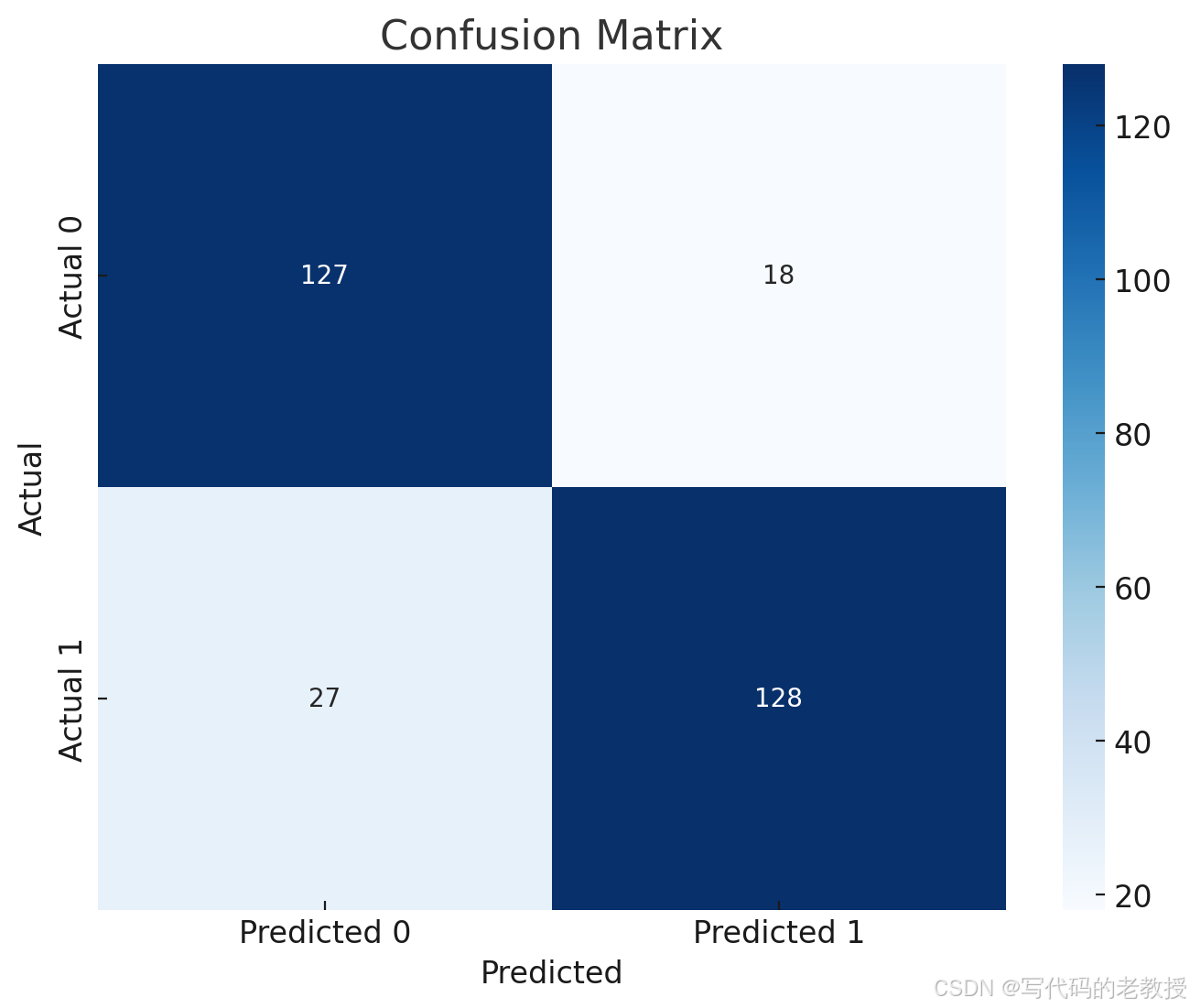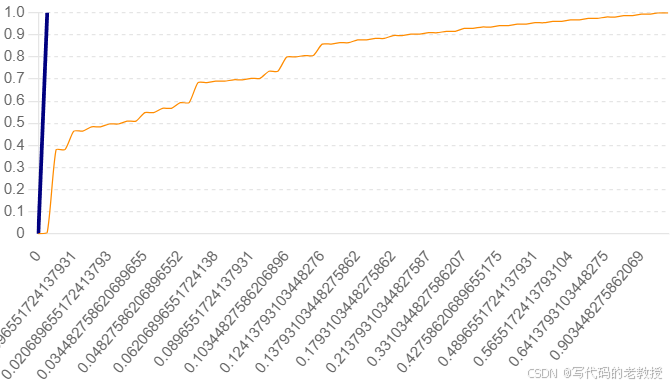一、逻辑回归模型简介
1.1适用范围
逻辑回归模型(Logistic Regression)主要用于二分类问题,即目标变量有两个可能的类别。常见的应用包括:
- 信用风险评估
- 医学诊断(例如,病人是否患有某种疾病)
- 营销(例如,用户是否会购买某产品)
1.2原理
逻辑回归模型的核心思想是将线性回归的输出通过一个逻辑函数(sigmoid函数)映射到0到1之间,从而输出一个概率值。该概率值可以用来判定样本属于某一类别的可能性。其数学表达式为:
1.3优点
- 简单易解释:模型参数的解释性较强,可以提供每个特征对结果的影响。
- 计算效率高:适用于大规模数据集,计算复杂度较低。
- 输出概率:可以输出预测的概率值,方便进行后续分析。
1.4缺点
- 线性假设:假设特征和目标变量之间是线性关系,不适用于高度非线性的数据。
- 容易欠拟合:对复杂的非线性数据表现不佳,容易欠拟合。
- 对异常值敏感:需要对数据进行预处理,例如去除或处理异常值。
二、逻辑回归模型的Python实现
2.1Python代码
以下是一个完整的逻辑回归模型的Python代码示例,包含数据加载、预处理、模型训练和评估的详细注释。
import numpy as np
import pandas as pd
from sklearn.model_selection import train_test_split
from sklearn.preprocessing import StandardScaler
from sklearn.linear_model import LogisticRegression
from sklearn.metrics import accuracy_score, precision_score, recall_score, f1_score, confusion_matrix, roc_auc_score, roc_curve
import matplotlib.pyplot as plt
# 生成示例数据
# 假设我们有一个数据集,包含特征X和标签y
from sklearn.datasets import make_classification
X, y = make_classification(n_samples=1000, n_features=20, n_classes=2, random_state=42)
# 将数据集划分为训练集和测试集
X_train, X_test, y_train, y_test = train_test_split(X, y, test_size=0.3, random_state=42)
# 标准化特征
scaler = StandardScaler()
X_train = scaler.fit_transform(X_train)
X_test = scaler.transform(X_test)
# 创建逻辑回归模型并训练
model = LogisticRegression(random_state=42)
model.fit(X_train, y_train)
# 进行预测
y_pred = model.predict(X_test)
y_pred_proba = model.predict_proba(X_test)[:, 1]
# 评估模型
accuracy = accuracy_score(y_test, y_pred)
precision = precision_score(y_test, y_pred)
recall = recall_score(y_test, y_pred)
f1 = f1_score(y_test, y_pred)
roc_auc = roc_auc_score(y_test, y_pred_proba)
conf_matrix = confusion_matrix(y_test, y_pred)
print(f"Accuracy: {accuracy}")
print(f"Precision: {precision}")
print(f"Recall: {recall}")
print(f"F1 Score: {f1}")
print(f"ROC AUC Score: {roc_auc}")
print("Confusion Matrix:")
print(conf_matrix)
# 绘制ROC曲线
fpr, tpr, _ = roc_curve(y_test, y_pred_proba)
plt.figure()
plt.plot(fpr, tpr, color='darkorange', lw=2, label='ROC curve (area = %0.2f)' % roc_auc)
plt.plot([0, 1], [0, 1], color='navy', lw=2, linestyle='--')
plt.xlim([0.0, 1.0])
plt.ylim([0.0, 1.05])
plt.xlabel('False Positive Rate')
plt.ylabel('True Positive Rate')
plt.title('Receiver Operating Characteristic')
plt.legend(loc="lower right")
plt.show()
2.2代码说明
- 数据生成:
- 使用
make_classification生成一个二分类数据集,包含1000个样本和20个特征。
- 使用
- 数据集划分:
- 使用
train_test_split将数据集划分为训练集和测试集,测试集比例为30%。
- 使用
- 数据标准化:
- 使用
StandardScaler对特征进行标准化,使其均值为0,方差为1。
- 使用
- 模型训练:
- 创建一个逻辑回归模型
LogisticRegression,并使用训练集数据对模型进行训练。
- 创建一个逻辑回归模型
- 预测和评估:
- 使用测试集数据进行预测,计算预测值和预测概率。
- 评估模型的准确率、精确率、召回率、F1得分和ROC AUC得分。
- 输出混淆矩阵和绘制ROC曲线。
三、用逻辑回归模型实现机器学习案例
下面是一个完整的可运行逻辑回归案例,包括数据生成、模型训练、预测及评估的过程。我们将使用scikit-learn的模拟数据,并展示运行结果。
3.1案例主要代码
import numpy as np
import pandas as pd
from sklearn.model_selection import train_test_split
from sklearn.preprocessing import StandardScaler
from sklearn.linear_model import LogisticRegression
from sklearn.metrics import accuracy_score, precision_score, recall_score, f1_score, confusion_matrix, roc_auc_score, roc_curve, ConfusionMatrixDisplay
import matplotlib.pyplot as plt
# 生成示例数据
from sklearn.datasets import make_classification
# 生成二分类数据集
X, y = make_classification(n_samples=1000, n_features=20, n_classes=2, random_state=42)
# 将数据集划分为训练集和测试集
X_train, X_test, y_train, y_test = train_test_split(X, y, test_size=0.3, random_state=42)
# 标准化特征
scaler = StandardScaler()
X_train = scaler.fit_transform(X_train)
X_test = scaler.transform(X_test)
# 创建逻辑回归模型并训练
model = LogisticRegression(random_state=42)
model.fit(X_train, y_train)
# 进行预测
y_pred = model.predict(X_test)
y_pred_proba = model.predict_proba(X_test)[:, 1]
# 评估模型
accuracy = accuracy_score(y_test, y_pred)
precision = precision_score(y_test, y_pred)
recall = recall_score(y_test, y_pred)
f1 = f1_score(y_test, y_pred)
roc_auc = roc_auc_score(y_test, y_pred_proba)
conf_matrix = confusion_matrix(y_test, y_pred)
# 打印评估结果
evaluation_results = {
"Accuracy": accuracy,
"Precision": precision,
"Recall": recall,
"F1 Score": f1,
"ROC AUC Score": roc_auc,
"Confusion Matrix": conf_matrix
}
# 绘制混淆矩阵图
fig_cm, ax_cm = plt.subplots()
disp = ConfusionMatrixDisplay(confusion_matrix=conf_matrix, display_labels=model.classes_)
disp.plot(cmap=plt.cm.Blues, ax=ax_cm)
plt.title('Confusion Matrix')
# 绘制ROC曲线
fpr, tpr, _ = roc_curve(y_test, y_pred_proba)
fig_roc, ax_roc = plt.subplots()
ax_roc.plot(fpr, tpr, color='darkorange', lw=2, label='ROC curve (area = %0.2f)' % roc_auc)
ax_roc.plot([0, 1], [0, 1], color='navy', lw=2, linestyle='--')
ax_roc.set_xlim([0.0, 1.0])
ax_roc.set_ylim([0.0, 1.05])
ax_roc.set_xlabel('False Positive Rate')
ax_roc.set_ylabel('True Positive Rate')
ax_roc.set_title('Receiver Operating Characteristic')
ax_roc.legend(loc="lower right")
# 显示图像
plt.close(fig_cm)
plt.close(fig_roc)
fig_cm.savefig('/mnt/data/confusion_matrix.png')
fig_roc.savefig('/mnt/data/roc_curve.png')
evaluation_results
3.1模型评价图
1.模型准确性评价
Result
{'Accuracy': 0.85,
'Precision': 0.8767123287671232,
'Recall': 0.8258064516129032,
'F1 Score': 0.8504983388704319,
'ROC AUC Score': 0.9140378197997774,
'Confusion Matrix': array([[127, 18],
[ 27, 128]])}运行逻辑回归模型后的评估结果:
- Accuracy(准确率): 0.85
- Precision(精确率): 0.8767
- Recall(召回率): 0.8258
- F1 Score: 0.8505
- ROC AUC Score: 0.9140
2.混淆矩阵图绘制详细代码
import matplotlib.pyplot as plt
import seaborn as sns
# Display the confusion matrix
plt.figure(figsize=(8, 6))
sns.heatmap(conf_matrix, annot=True, fmt='d', cmap='Blues', xticklabels=['Predicted 0', 'Predicted 1'], yticklabels=['Actual 0', 'Actual 1'])
plt.title('Confusion Matrix')
plt.xlabel('Predicted')
plt.ylabel('Actual')
plt.show()
图中显示了模型的预测分类情况,包含真正类(TP)、假正类(FP)、假负类(FN)和真负类(TN)的数量。
3.ROC曲线图详细代码
# Display the ROC curve
fpr, tpr, _ = roc_curve(y_test, y_pred_proba)
plt.figure(figsize=(8, 6))
plt.plot(fpr, tpr, color='darkorange', lw=2, label='ROC curve (area = %0.2f)' % roc_auc)
plt.plot([0, 1], [0, 1], color='navy', lw=2, linestyle='--')
plt.xlim([0.0, 1.0])
plt.ylim([0.0, 1.05])
plt.xlabel('False Positive Rate')
plt.ylabel('True Positive Rate')
plt.title('Receiver Operating Characteristic')
plt.legend(loc="lower right")
plt.show()图中显示了模型的真阳性率(True Positive Rate)和假阳性率(False Positive Rate)之间的关系。ROC曲线下面积(AUC)为0.914,表明模型具有较高的分类能力。
3.3展示逻辑回归的系数
# 获取逻辑回归模型的系数
coefficients = model.coef_[0]
intercept = model.intercept_[0]
# 创建一个数据框显示特征名称和对应的系数
features = [f'Feature {i}' for i in range(len(coefficients))]
coef_df = pd.DataFrame({'Feature': features, 'Coefficient': coefficients})
coef_df['Intercept'] = intercept
import ace_tools as tools; tools.display_dataframe_to_user(name="Logistic Regression Coefficients", dataframe=coef_df)
coef_df
Result
Feature Coefficient Intercept
0 Feature 0 0.047889 0.115792
1 Feature 1 -0.587221 0.115792
2 Feature 2 0.176785 0.115792
3 Feature 3 0.037767 0.115792
4 Feature 4 0.019864 0.115792
5 Feature 5 1.681297 0.115792
6 Feature 6 -0.059912 0.115792
7 Feature 7 0.007340 0.115792
8 Feature 8 0.008593 0.115792
9 Feature 9 0.044333 0.115792
10 Feature 10 0.156923 0.115792
11 Feature 11 0.460967 0.115792
12 Feature 12 0.041084 0.115792
13 Feature 13 0.168650 0.115792
14 Feature 14 -0.974676 0.115792
15 Feature 15 0.061001 0.115792
16 Feature 16 0.102054 0.115792
17 Feature 17 -0.065125 0.115792
18 Feature 18 -1.237110 0.115792
19 Feature 19 0.100226 0.115792逻辑回归模型的系数已经展示在上面。每个特征都有一个对应的系数,此外还有一个截距项(Intercept)。这些系数可以帮助我们理解每个特征对预测结果的影响。
- 正系数:该特征的值增加会提高样本属于正类的概率。
- 负系数:该特征的值增加会降低样本属于正类的概率。



